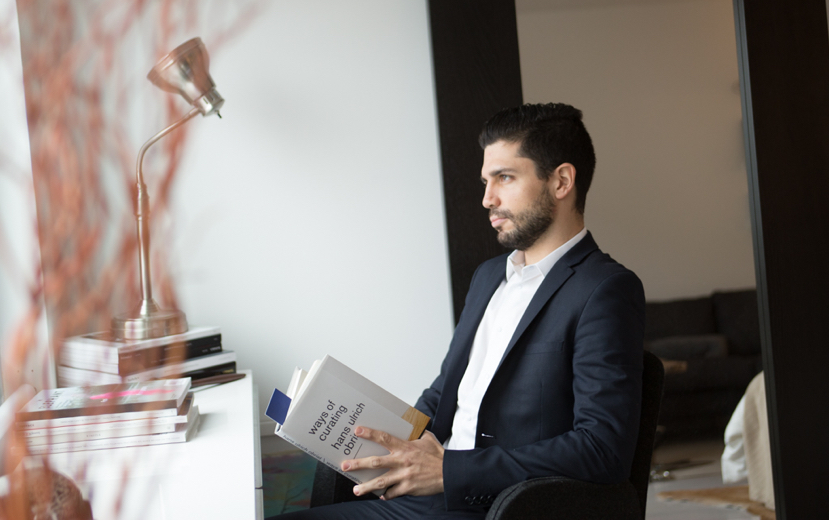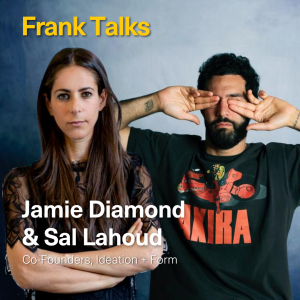In this week’s Frank Talk we sit down with Alejandro Jassan, who is the Director of Communications at Alexander Gray Associates in New York. Alejandro is also a curator and a critic. He is a contributing writer for Elle Mexico, Quien, Elle Decoration, Elle Man, and The Coastal Post, among others. We are excited to share his experience in the arts with you here!
What was your first job in the Arts?
My first job in the arts was at Elle Mexico—where I am still an art critic. But back then I was a graphic designer for the magazine, and even though I was mostly working on images and layouts, I was always intrigued by the Arts & Culture section, which reviewed art exhibitions, books, etc. After writing a few short notes about fashion here and there, I discovered that I enjoyed writing—more so than I ever imagined—, and suddenly found myself writing about all these fun topics, including fashion, traveling, and most excitingly, contemporary art. It didn’t take long for me to realize that writing was a key to meeting artists and an excuse to visit their studios. That is how I ended up writing major profiles on top names like Martin Schoeller and Kwang Young Chun.
What was the most useful or important thing you learned at that job?
During my time at Elle Mexico I learned the importance of teamwork. The whole company worked as a production line, and we needed to work with each other to get an idea materialize and finally get printed into a magazine. Those work ethics have stayed with me throughout the years and now help me when curating and organizing exhibitions. At the end of the day, we need to find a goal in common between artists, institutions, critics, and collectors, and then—as a team—materialize them into exhibitions, publications, etc.
Tell us a little more about yourself. When did you realize you wanted to pursue a career in this industry?
After writing a few articles about contemporary art for Elle I realized that it was much more than a hobby—it had become a lifestyle. I did some research and found out that Sotheby’s Institute of Art in New York was offering a master’s degree course in contemporary art. In a way, it made me realize that it could become a career for me. In less than three months I was packing my bags and flying out to New York to start graduate school.
What do you do now?
I am a curator and critic. I work at Alexander Gray Associates gallery in New York, where I organize exhibitions for top international artists, including Jack Tworkov, Joan Semmel, Melvin Edwards, and Betty Parsons, among others. I have also curated exhibitions at Spring/Break Art Show and co-curated the first New York show of Mexican painter, Jorge Tellaeche. Excitingly, I recently curated an exhibition at The Java Project gallery in Brooklyn of new and recent paintings by Evan Halter. When I am not curating a show, you can find me at a local coffee shop writing about art or transcribing an interview.
Where are you from?
I am from Mexico: the land of mariachi, tequila, and one of the most exciting contemporary art scenes.
What is the arts community like there?
It’s fascinating! The community is very tight-knit, where everyone knows each other and also wants to help each other. There are dozens of new galleries and artist run spaces that are putting together very exciting programs. Last time I went on an art walk in Mexico City I came across engaging artworks, including a very thought-provoking exhibition by Yoshua Okón at Parque Galería, and a fascinating installation by Nairy Baghramian at Kurimanzutto Gallery. The best time to go is during art fair season, where Material Art Fair and Zona Maco bring artists and galleries from all over the world for a great art—and party—week!
Has where you come from shaped what you do in the arts today?
It definitely has. I grew up in a country full of culture and art, where creativity can be found in every corner, from food and traditions to architecture and lifestyle. I almost wish I could go back in time to those school trips to visit Diego Rivera’s murals! At the time they seemed a bit boring to me, but now I see the impact they had on me.
What is the best piece of advice you can give about working in the art world?
My best advice is to stay humble and work hard. New York City—and any other big city really—can be very competitive environments. If your work ethics are good, you can achieve better results. It is also very important to have a sense of teamwork. In the art world you are only a part of a larger industry, which means you have to work with other people.
What is one of your greatest accomplishments in your career so far?
I am always amazed by the impact we have in artists careers. One of the greatest accomplishments for me and my team is to see an artwork leave the artist’s studio and be placed into a museum’s collection. We of course know how important the work is, so then we take on the responsibility of making sure that these works are represented in important collections. We are actively enhancing contemporary art history, and that fascinates me.
What has been a challenge for you?
A challenge has been seeing the art market fluctuate. Since the beginning of this decade, there was a lot of interest in contemporary art—particularly with emerging artist—but suddenly around 2015 the market came to stand still, and I saw many of my friends and peers suffer from this sudden drop in sales. Many galleries were forced to close. It was heartbreaking. On the other hand, I have seen many people think creatively about how we can solve these problems, as a team.
What is something you do every day at work?
I read the (art) news outlets. Every. Single. Day. There are some art critics that I follow religiously, including Alex Greenberger from ARTnews or Jillian Steinhauer from The New York Times, but I try to cover all the news each day to stay informed on what exhibitions are traveling, what curators are looking at, and any other gossip that might be worth talking about at dinner time.
What is one of the weirdest things you have had to do on the job in your career?
One time I traveled with Luis Camnitzer for a Museum opening in Mexico City, and he kept telling all these important curators and collectors that I was his bodyguard. He was joking of course, but at the time I felt intimidated and kept blushing every time he said so! At the end of the day, it was a very fun trip. We even went antique shopping.
What defines a good employee? What defines a good boss?
A good employee is pro-active. I think most jobs come with challenges and it is always appreciated when an employee brings you a solution to a problem, rather than asking you to solve it. On the other hand, a good boss is someone who makes all the tools available for an employee to solve any questions they may have.
What do you think makes a person hirable?
Whenever I am interviewing candidates for a position I make sure they have knowledge about the company and the artists we work with. In my mind, a person who *really* wants to work here has read our press releases, browsed our website, and even seen our Instagram posts. A great way to divide those who are interested from the ones who aren’t is by simply asking, “which artist in the program interests you the most?” You’d be surprised at how many people come without an answer to that!
What is your advice to making yourself stand out in your workplace?
A “good morning” with a smile goes a long way. Most of us spend long hours at work, so it is important to set a friendly tone with your co-workers.
What are things you can do proactively boost your CV?
I think keeping it up to date is important, even when you are not looking for a job. I see my CV as an archive of my professional benchmarks and it helps me think proactively about new goals for the future.
Are there any tips you can give people entering the workforce?
Stay informed. Go to exhibitions, meet artists, stay curious. Most of us have an idea of what the art world is, but once you are thrown in the mix you learn that you enjoy certain things more than others. I recommend going out for informal interviews to figure out what “avenue” you’d be interested in taking. The good thing is that the art industry tends to be fun, exciting, and very rewarding, no matter which direction you go into.
In your experience, what are things to do and things to avoid during an interview?
I think it is very important to come prepared: print out a few copies of your CV, know who you are meeting with, and study the company. Not to be shallow, but I do think it’s important to dress up for an interview. I would not recommend to wear sneakers or a t-shirt. An interview is a first impression, and we all know those are hard to rectify!
What is the best exhibition you have seen in the last year?
I would have to say that Programmed: Rules, Codes and Choreographies in Art. 1965–2018, which is currently on view at the Whitney Museum of American Art in New York is one of my favorites so far. I believe the exhibition happened after the restoration of Nam June Paik’s 1989 monumental work Fin de Siècle II, and all the works included deals with the production of art through rules, instructions, and code. It’s really fascinating!
If you could own a work by 5 different artists, who would be in your collection?
Without any monetary restrictions?! I would love to own a 1970s Joan Semmel painting, an outdoor sculpture by Elmgreen and Dragset, a still life painting by Holly Coulis, a video installation by Alex Da Corte, and a horse painting by TM Davy. One can only wish, right?




